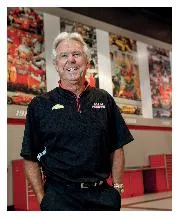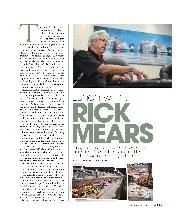“That was Saturday night,” recalls Ribbs. “On Tuesday, Walker had the money in his account.
“He called me and said ‘The money is there – in the bank!’ Walker was excited as a blind dog in a butcher’s shop!”
After years of chasing budgets to go racing, Walker couldn’t quite believe someone just handing the cash over. Part of the building excitement wasn’t just that a fast driver and able team manager were joining forces – they also had one of the best race engineers in the business.
“Derrick had Tim Wardorp – he was the man,” says Ribbs.
“With every race driver that I’ve ever known, there’s an energy that they will get from engineers that they’re close to or that they trust.
“Indianapolis is just so dangerous, you need that trust in your engineer. Fernando Alonso will tell you how difficult Indy is and what it does to you mentally – at 11am you think you’re one bad cat, at 3pm you think you’re a bum!”
Ribbs would certainly need confidence – in spades – from the team, because he wasn’t going to get it from his car.
Newly christened ‘Walker Racing’ had purchased a year-old Lola chassis to compete that year. In terms of absolute IndyCar pace, the chassis was already obsolete. The Cosworth DFS engine that came with it wasn’t much better.
This point was hit home during the 1991 Rookie Orientation Programme (ROP) held at Indianapolis in late April. The Walker driver couldn’t get his car much over 200mph, far off the pace needed to gain approval to enter qualifying for that year’s 500. The solution was to change the Cosworth power unit for something much more powerful.
The team opted for a Buick engine, known to be packed with horsepower, but also heavy and not altogether reliable.
Matters were not helped further by the fact that Ribbs couldn’t get truly let rip on track. He knew that if he damaged the car, all their efforts would come to null.
“There was no margin for error,” he says. “I didn’t have a back-up car, so I couldn’t go out there and take any unnecessary chances. I couldn’t jump into the pool with both feet – I had one foot in at a time.”
Luckily, Wardrop’s ice-cool approach to racing brought a serenity over Ribbs in focusing on the job in hand. The historical significance weighing over his driver had the potential to blow him off course.
“There was media asking me: ‘Do you feel like you’re responsible for 50 million African-Americans?'”
“I was spending so much time with Tim on the laptop,” he remembers. “He was just so good and had a very calm demeanour, nothing got him excited – nothing! What he wanted to do was to not get me amped up.”
“There was media everywhere, asking me these questions: ‘Do you feel like you’re responsible for 50 million African-Americans? Do you think you have to succeed because 50 million African Americans are watching and praying? And, if you don’t, maybe there won’t be another African American racing for a hundred years?’ All these kind of questions!”
At least for the majority of the time, Ribbs managed to shut out the noise. Though he may now appreciate the meaning of what he achieved for black people around the world, at the time he was focused simply on qualifying.
“My number one responsibility was to myself, my team, sponsors and my family. Not for anyone else,” he asserts.





